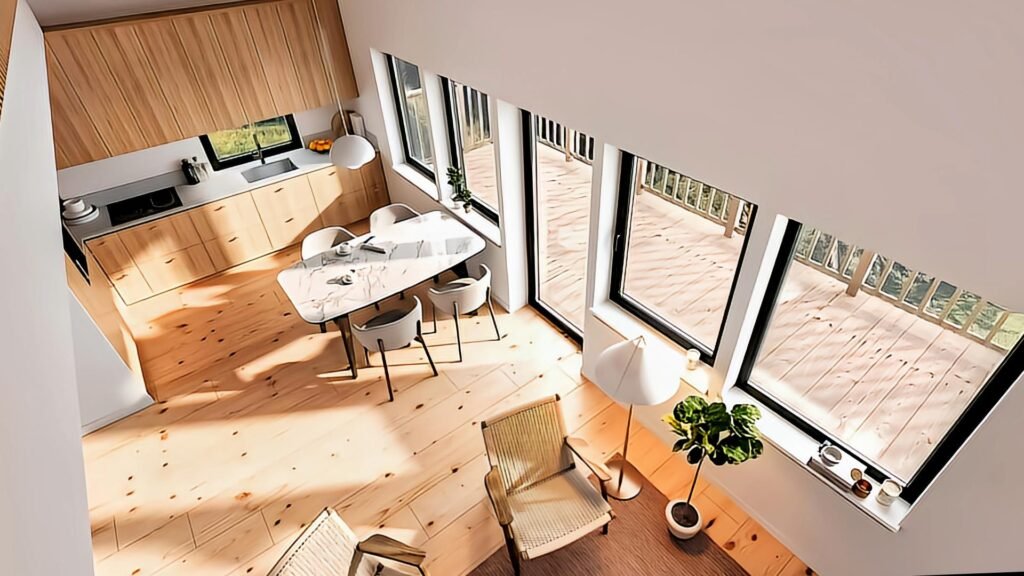Explore the sixth chapter of ’50 Calming Interior Decor Solutions’. Learn to create a serene and tranquil home using white, neutrals, and natural wood. Discover techniques for balancing these elements to ensure a harmonious and relaxing living space, combining aesthetic appeal with sustainability. Dive into advanced ideas for a calming interior design.
Introducing Part Six: The Final Chapter of Tranquil There
Welcome to the final chapter of our series “50 Calming Interior Decor Solutions,” where we delve into the serene world of white, neutrals, and natural wood. Throughout this journey, we have explored numerous aspects of creating a peaceful sanctuary within your home, and in this concluding installment, we bring all these elements together to provide a comprehensive guide to tranquility and simplicity in interior design.

The principles of using white and neutral tones, combined with the organic charm of natural wood, are pivotal in crafting spaces that exude calm and relaxation. White’s purity and cleanliness can brighten a room, creating an airy, open feel that encourages peace. Neutral colors like beige, taupe, and gray add layers of subtle warmth and sophistication, seamlessly integrating with various design styles while maintaining a calming ambiance.
Please read our article watch the newly uploaded video from our YouTube channel:
“Grig Stamate – Interior Design Solutions”
https://www.youtube.com/@GrigStamate
50 CALMING Interior Decor Solutions – White, Neutrals, and Natural Wood, #6 (video)
Here, you can see other related videos from our channel:
50 CALMING Interior Decor Solutions – White, Neutrals, and Natural Wood, #4 (video)
50 CALMING Interior Decor Solutions – White, Neutrals, and Natural Wood, #5 (video)
Natural wood stands out as a timeless element in interior decor, imbuing spaces with warmth and texture. The interplay between white, neutrals, and wood forms a harmonious balance, each complementing the other to create a cohesive and tranquil environment. This blend is not only visually soothing but also promotes a connection to nature, which is essential for mental well-being.
As we embark on this final chapter, we will explore advanced techniques and ideas for incorporating these calming elements into your living spaces. We’ll revisit some of the standout solutions from previous chapters and introduce new ones to inspire your decor endeavors. Expect to find detailed discussions on the interplay of light and color, innovative uses of texture, and strategies for integrating natural elements that promote relaxation and serenity.
This culmination of our series aims to equip you with the knowledge and inspiration to transform any space into a tranquil retreat. As we reflect on the journey so far, let’s look ahead to a future of serene, beautifully curated interiors that bring calm and joy into everyday life.
Incorporating Natural Wood: Warmth and Sustainability
Integrating natural wood into interior spaces not only enhances aesthetic appeal but also brings the enduring benefits of warmth and sustainability. Each type of natural wood conveys a different mood while maintaining a calming ambiance, ranging from light oak to rich walnut. Light oak, known for its subtle charm and neutral tones, effortlessly creates an airy and inviting atmosphere, making it an ideal choice for contemporary and minimalist interiors. On the other hand, the deep, rich hues of walnut exude a sense of opulence and grounding, which is perfect for traditional or mid-century modern settings.
The benefits of natural wood extend beyond its visual charm. Sustainable sourcing of wood is crucial for promoting eco-friendly interior designs. Choosing certified wood products ensures that forests are managed responsibly, supporting forest regeneration and biodiversity. Sustainable timber harvesting practices are pivotal in maintaining ecological balance, and selecting reclaimed or recycled wood further reduces the environmental impact. These practices contribute to a more sustainable planet and allow homeowners to enjoy the natural beauty of wood guilt-free.
Natural wood can be applied in various practical ways within home decor. Wooden furniture pieces, such as dining tables, chairs, and bookshelves, serve as focal points that bring together function and elegance. Wood flooring not only provides a durable and long-lasting solution but also introduces natural texture and warmth to the room. Decorative accents, including wooden picture frames, wall panels, or even small accessories like bowls and trays, can add subtle hints of natural beauty, tying the decor scheme cohesively.
The video series showcases exceptional real-world examples of how natural wood can transform interiors. From rustic wooden beams adding character to living spaces to bespoke walnut cabinetry elevating the sophistication of a kitchen, these applications demonstrate the versatility and charm of natural wood. The rich textures, warm tones, and inherent patterns of wood not only enhance the visual appeal but also foster a sense of grounding and comfort, making any room feel more welcoming and harmonious.
The Elegance of White and Neutrals: Creating a Serene Backdrop
White and neutral colors are quintessentially linked to notions of purity, openness, and tranquility. In interior decor, these hues are known for their capacity to evoke spaciousness and serenity, qualities that make them perfect choices for calming living environments. The psychological impact of white and neutral tones cannot be overstated; they help reduce stress, promote mental clarity, and foster a sense of balance.
When used effectively, a white or neutral palette can transform any living space into a haven of peace. In living rooms, for example, soft beige walls paired with white sofa sets contribute to an inviting and restful atmosphere. Similarly, a creamy off-white bedroom enhances a sense of restfulness conducive to sleep. In kitchens, a blend of light grays and whites not only brightens up the space but also creates a clean, organized visual appeal.
However, achieving the right balance with white and neutral interiors is crucial to avoid a sterile and clinical look. Incorporating a mix of textures and subtle patterns can add depth and warmth, ensuring that the space remains cozy. For instance, pairing a white linen couch with a chunky knit throw and patterned pillows can soften the room while maintaining an elegant ambiance. Adding natural wood elements, such as oak flooring or beech cabinetry, introduces a tactile contrast that further enriches the decor.
Examples from our video series highlight these principles wonderfully. Viewers will notice how a simple, sand-colored living room is brought to life with a textured wool rug and wooden coffee table, showcasing how layered textures add dimension. In another segment, a pristine white kitchen is enhanced with subtle, patterned backsplash tiles and soft wooden accents, demonstrating the harmony between purity and warmth.
It’s essential to maintain these color schemes meticulously. Regular cleaning and occasional fresh paint touch-ups can prolong the crispness of white and neutral shades. Additionally, integrating elements like houseplants, vases, or soft-colored artwork can revitalize the space without disrupting its serene essence. This combination of careful maintenance and thoughtful enhancement can create interiors that are not only elegant but also deeply calming.
Combining Elements for a Harmonious Home
Creating a harmonious home environment involves the strategic blend of white, neutrals, and natural wood elements to achieve a balanced and tranquil space. The synergy of these components can be attained through careful planning and thoughtful execution. When mixing and matching, it’s vital to focus on maintaining an equilibrium that doesn’t overwhelm the space but rather enhances its natural calmness.
Layering textures is one of the most effective methods to add depth and interest while using a restricted color palette. For instance, a white linen sofa paired with a neutral-toned jute rug can create a diverse yet cohesive look. Add natural wood coffee tables or side tables to introduce warmth and earthy tones. This layering technique was demonstrated in several video series examples where textured throws, wooden accents, and neutral backdrop walls combined seamlessly to produce a serene ambiance.
Incorporating complementary decor pieces is another crucial aspect. Decorative items like pale-colored ceramics, soft-hued cushions, and minimalist art pieces can tie together the overall theme. Select items that echo the core palette without clashing. For instance, subtly patterned cushions in shades of beige, taupe, or grey can merge the starkness of white with the richness of wood, achieving an elegant balance. Wooden frames on mirrors or artwork further blend the elements smoothly.
Ensuring a smooth flow from room to room is essential in maintaining harmony throughout your home. For instance, continuity can be maintained by using similar color tones and materials in shared spaces such as living rooms and adjacent dining areas. Light oak flooring that runs through different rooms can unify the spaces while keeping them airy and interconnected.
Here are some actionable tips for incorporating calming interior solutions into your home:
1. Start with a neutral base and build upon it with white and wood elements.2. Use a variety of textures to add interest without overcrowding the space.3. Incorporate complementary decor pieces that enhance the core palette without overwhelming it.4. Maintain consistent flooring or color tones to ensure a seamless flow between rooms.
By carefully blending white, neutrals, and natural wood, you can create a harmonious and tranquil environment that radiates calm and balance, turning your home into a serene sanctuary.
Other related posts from our website:
Let’s see here, three of them:
https://howtobuildahouseblog.com/design-trends-balance-and-harmony-calm-with-a-flash-of-color/
https://howtobuildahouseblog.com/how-you-can-create-an-interior-with-calm-and-modern-comfort/
We also sincerely hope you like our ideas from this post, and you have also enjoyed our uploaded YouTube video.
See you next time at another article.
Thank you so much for your time. Bye now!



No Responses